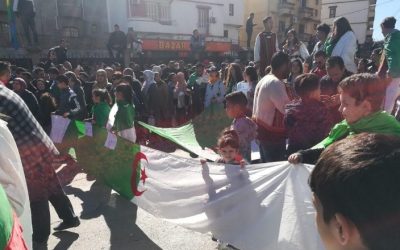Historical Roots of Algerian Art
The historical roots of Algerian art trace back to ancient civilizations that inhabited the region, including the Berbers, Phoenicians, Romans, and Arabs. These diverse cultural influences shaped a rich artistic heritage characterized by intricate craftsmanship, vibrant motifs, and symbolic representations. Over centuries, Algerian art evolved through the fusion of indigenous traditions and external influences, reflecting the complex history and cultural identity of the nation. This heritage lays a profound foundation for understanding the contemporary expressions of Algerian artistic culture today.
Prehistoric Rock Art
The historical roots of Algerian art are deeply connected to its rich prehistoric history, particularly evident in the ancient rock art found across the region. These early artworks, created by nomadic tribes and early inhabitants, date back to the Neolithic and Paleolithic periods. The prehistoric rock art in Algeria primarily consists of petroglyphs and cave paintings, which depict animals, human figures, hunting scenes, and symbolic motifs. These images offer invaluable insights into the lives, beliefs, and environment of early Algerian communities. The rock art sites, scattered throughout the Sahara Desert and the Tell Atlas region, demonstrate the artistic expression and cultural development of prehistoric peoples long before written history. This ancient artistic tradition laid the foundation for the diverse and vibrant artistic heritage that would evolve in Algeria through the ages, influencing later Islamic, Berber, and Arab artistic styles present in the country today.
Islamic Tilework and Calligraphy
The historical roots of Algerian art are deeply intertwined with its rich cultural and Islamic history, reflecting a blend of indigenous Berber traditions and Islamic influences that have shaped the region over centuries. Algeria’s strategic position along Mediterranean trade routes facilitated the exchange of artistic techniques and motifs, contributing to a unique cultural identity expressed through various forms of visual and decorative arts.
Islamic tilework and calligraphy hold a significant place in Algerian artistic heritage, showcasing the mastery of artisans in creating intricate patterns and expressive inscriptions. Islamic tilework in Algeria often features geometric and vegetal motifs, with a focus on symmetry and harmony, serving both functional and decorative purposes in mosques, palaces, and public spaces. Calligraphy, particularly Arabic script, is celebrated for its elegance and spiritual significance, often used to adorn religious texts, architectural elements, and decorative objects, reflecting the profound influence of Islamic culture on Algerian art.
Colonial Influences and Transformation
The historical roots of Algerian art are deeply intertwined with its rich cultural heritage, reflecting a blend of indigenous Berber traditions, Arab influences, and later, external elements introduced through centuries of migration and conquest. Prehistoric cave paintings, such as those found in the Tassili n’Ajjer region, reveal some of the earliest expressions of Algerian artistic endeavors, illustrating scenes of daily life and spiritual beliefs of ancient inhabitants.
During the Islamic period, calligraphy, geometric patterns, and intricate tile work became prominent features of Algerian art, showcasing the region’s enduring Islamic identity. The arrival of the Ottoman Empire in the 16th century further enriched this artistic landscape, introducing new motifs and techniques that merged with local traditions.
Colonial influences, particularly under French rule from 1830 to 1962, significantly impacted Algerian art. European styles such as Romanticism, Realism, and Impressionism were introduced and sometimes adopted by local artists. Conversely, colonial authorities often marginalized indigenous artistic practices, aiming to impose Western aesthetic standards and suppress native cultural expressions. Despite this, many Algerian artists began to incorporate colonial themes into their work or used art as a form of resistance and cultural assertion.
The transformation of Algerian art in the post-colonial era reflects a reclaiming of national identity. Artists sought to revive and celebrate traditional motifs, craft techniques, and cultural symbols, blending them with modern influences to foster a sense of pride and continuity. Today, Algerian art continues to evolve, recognizable through its dynamic fusion of historical roots, colonial legacies, and contemporary innovation, serving as a vital expression of the country’s complex history and vibrant cultural identity.
Traditional Algerian Artistic Expressions
Traditional Algerian artistic expressions reflect the rich cultural heritage and diverse history of the country. From intricate embroidery and vibrant pottery to mesmerizing music and dance, these art forms showcase the creativity and identity of various Algerian communities. Rooted in centuries-old traditions, they serve as a vital link to Algeria’s past and continue to influence contemporary artistic practices.
Berber Bohemian and Textile Arts
Traditional Algerian artistic expressions are a vibrant reflection of the country’s rich cultural heritage, blending influences from Arab, Berber, and French origins. Among these, Berber bohemian and textile arts hold a special place, showcasing intricate craftsmanship and symbolic designs that have been passed down through generations. Berber bohemian style is characterized by colorful, free-spirited motifs often seen in jewelry, clothing, and accessories, emphasizing individuality and cultural identity. Textile arts in Algeria are renowned for their detailed embroidery, weaving, and dyeing techniques, notably in items like carpets, rugs, and traditional clothing. These textiles often feature geometric patterns, motifs inspired by nature, and symbols representing social status and regional identity. Overall, these artistic expressions are vital to preserving Algeria’s diverse cultural legacy and continue to influence contemporary art forms within the country.
Pottery and Ceramics
Traditional Algerian artistic expressions, including pottery and ceramics, are an integral part of the nation’s rich cultural heritage. These art forms reflect the diverse influences of Berber, Arab, Ottoman, and French civilizations that have shaped Algeria over centuries. They serve not only functional purposes but also symbolize social identity, tradition, and local craftsmanship.
- Algerian pottery is renowned for its intricate designs and vibrant colors, often featuring geometric patterns, floral motifs, and calligraphy. These patterns are inspired by indigenous Berber symbols and Arab artistic elements.
- Ceramics are traditionally handmade using locally sourced clay, with techniques passed down through generations. Craftsmanship is highly valued, and each piece often reflects the artisan’s personal style and regional identity.
- Commonly produced items include storage jars, coffee pots, bowls, and decorative tiles. These items are used in daily life and also as decorative objects that showcase Algerian creativity.
- In regions like Kabylie, the craftsmanship emphasizes bold, colorful patterns, while in the M’zab Valley, the ceramics tend to feature more subtle, elegant designs with a focus on functionality.
- Modern Algerian artists continue to innovate within this traditional craft, blending contemporary aesthetics with age-old techniques, thereby keeping the artistic heritage alive and relevant.
Folk Music and Dance Forms
Traditional Algerian artistic expressions encompass a rich tapestry of folk music and dance forms that reflect the diverse cultural heritage of the country. These cultural elements have been passed down through generations, serving as a vital form of storytelling and communal celebration. Music genres such as Rai, Chaabi, and Andalusi classical music highlight the blend of Arab, Berber, and Mediterranean influences, creating uniquely vibrant soundscapes. Dance forms like the Ahidous, a Berber circle dance, and the Saharan Ahaggar dances showcase the expressive movements and rituals rooted in daily life and spiritual practices. Craftsmanship also plays a significant role, with intricate embroidery, pottery, and jewelry underscoring the artistic mastery involved in traditional Algerian arts. Collectively, these expressions foster a strong sense of identity and cultural pride while offering a window into the historical and social fabric of Algeria.
Major Artistic Movements in Algeria
Algeria’s art scene is deeply rooted in its rich cultural history and has evolved through a variety of major artistic movements. These movements reflect the country’s diverse influences, from indigenous Berber traditions to Arab, French, and modern global artistic trends. Understanding these key movements provides insight into Algeria’s unique artistic identity and its journey through colonialism, independence, and contemporary expression.
Modernist Movements and Their Pioneers
Algerian art has a rich and diverse history, reflecting the country’s cultural depth and historical experiences. Among the major artistic movements in Algeria, traditional Berber and Arab influences have played a significant role in shaping the aesthetic and thematic elements of its artistic heritage. In the modern era, Algeria witnessed the emergence of modernist movements that sought to break away from classical conventions and embrace new forms of expression. These movements often intertwined with the country’s political and social upheavals, especially during and after the struggle for independence.
Modernist movements in Algeria, flourishing mainly in the mid-20th century, include influential groups and artists who pioneered innovative approaches to art. The École d’Alger (School of Algiers), founded by the artist Baya Mahieddine, became notable for blending traditional Oriental themes with modernist techniques, creating a unique visual language. Another significant figure is Mohamed Racim, renowned for his mastery of miniature painting and his efforts to revive traditional Algerian artistic techniques while integrating modernist sensibilities. These pioneers challenged and expanded the boundaries of Algerian art, fostering a cultural renaissance that continues to influence contemporary artists today.

Contemporary Art Trends
Algeria’s art scene is rich with historical movements and evolving contemporary trends that reflect its diverse cultural heritage and modern experiences. Major artistic movements in Algeria include traditional forms rooted in Berber, Arab, and French influences, as well as modernist and avant-garde approaches that emerged in the 20th century.
- Algerian Popular Artistic Movements: Traditional art forms such as Berber jewelry, pottery, and music like Rai and Chaabi music are vital elements of Algeria’s cultural identity. These emphasize community, storytelling, and regional identities.
- Modernist and Nationalist Movements: During the struggle for independence, art became a form of resistance, with artists like Jean Bertrand and Baya creating work that highlighted national pride and anti-colonial themes.
- Post-Independence Art: The post-1962 period saw a surge in abstract painting, murals, and sculptures, often reflecting social issues, political activism, and identity reconstruction.
- Contemporary Art Trends: Today, Algerian contemporary art is characterized by diverse expressions including installation, digital art, performance, and street art. Young artists explore themes such as migration, gender, and identity, often blending traditional motifs with global modernist styles.
Impact of Political and Social Changes
Algerian art has been deeply influenced by its rich history and evolving societal landscape, reflecting the country’s complex identity through various major artistic movements. During the colonial period, European artistic styles such as Romanticism and Realism introduced new techniques and themes, often intertwined with themes of national identity and resistance. The emergence of the Algerian Revolution in the 1950s fostered a new wave of nationalist art, incorporating traditional Berber and Arab motifs to celebrate cultural heritage and resistance against colonization. Post-independence, modernist movements such as Abstract and Contemporary Art gained prominence, emphasizing individual expression and social commentary. Political upheavals and social changes have continually shaped artistic expression in Algeria, encouraging artists to challenge norms, explore cultural roots, and address ongoing societal issues. These movements illustrate how art in Algeria is a vibrant reflection of its socio-political history, serving both as a form of cultural preservation and a tool for political discourse.
Key Algerian Artists and Their Contributions
Algerian art is a vibrant reflection of the country’s rich cultural heritage and history, showcasing a diverse array of creative expressions. Key Algerian artists have played a significant role in shaping the nation’s artistic landscape, blending traditional elements with modern influences. Their contributions span various mediums including painting, music, sculpture, and literature, highlighting the depth and diversity of Algerian artistic talent.
Jean Lauda and Modernist Sculpture
Algerian art has been significantly shaped by influential artists who have contributed to both traditional and modernist movements. Among these, Jean Lauda stands out as a pivotal figure in modernist sculpture, profoundly impacting the development of contemporary art in Algeria. His work embodies a blend of innovative techniques and cultural expression, reflecting the country’s rich heritage and evolving identity.
- Jean Lauda was a French-Algerian sculptor renowned for his abstract and modernist approach, pioneering new forms and materials that challenged conventional sculpture.
- He played a vital role in the modernization of Algerian art, introducing experimental techniques that influenced a new generation of artists.
- Lauda’s work often explores themes of identity, history, and socio-political issues, making his sculptures both visually striking and culturally meaningful.
- In the context of Algerian art, his contributions helped elevate modernist sculpture to a prominent position, encouraging greater experimentation and expression.
Ali Khodja and Painting
Algerian art boasts a rich history shaped by numerous influential artists who have significantly contributed to its development. Among these, Ali Khodja stands out as a prominent figure known for his mastery in painting and his role in fostering cultural expression in Algeria. Khodja’s work integrates traditional Islamic artistic motifs with contemporary styles, creating a unique visual language that reflects Algeria’s cultural diversity. His paintings often depict historical scenes, everyday life, and spiritual themes, capturing the essence of Algerian identity. Through his innovative approach, Ali Khodja has helped elevate Algerian art on the international stage, inspiring future generations of artists.
Reem Kherici and Multimedia Art
Algeria boasts a rich artistic heritage with numerous influential artists and innovative contributions to the global art scene. Reem Kherici, although primarily recognized as an actress and filmmaker, has also impacted the cultural landscape through her creative storytelling and performances that often highlight Algerian identity and social themes. Her work emphasizes the importance of cultural representation and contemporary narratives within Algerian art and cinema.
In addition to individual artists like Kherici, Algeria has a vibrant tradition of multimedia art that encompasses visual arts, digital installations, and new media practices. Algerian multimedia artists explore themes such as history, identity, migration, and political expression, often blending traditional motifs with modern technology to create compelling and thought-provoking works.
- Reem Kherici’s work reflects a blend of cultural heritage and contemporary themes, enriching Algerian artistic discourse through film and performance.
- Algerian multimedia artists are pioneers in integrating technology with art, pushing boundaries and engaging diverse audiences.
- The country’s art scene is characterized by a dynamic mix of traditional influences and modern innovation, contributing to its vibrant cultural identity.
Algerian Art Institutions and Festivals
Algeria boasts a rich cultural heritage demonstrated through its vibrant art scene, supported by a diverse array of art institutions and festivals. These venues and events play a crucial role in promoting local artists, preserving traditional crafts, and fostering contemporary artistic expression. From renowned galleries to lively annual festivals, Algeria’s art institutions serve as vital platforms for showcasing the country’s creative talents and celebrating its cultural diversity.
Museum of Modern Art in Algiers
Algeria has a rich cultural heritage that is celebrated through various art institutions and festivals. The Museum of Modern Art in Algiers stands out as a prominent venue dedicated to showcasing contemporary African and Algerian art, fostering local talent and promoting cultural dialogue. This museum plays a vital role in preserving and promoting modern artistic expressions and providing a platform for artists to exhibit their work to both national and international audiences.
- Algerian National Museum of Fine Arts: Houses a vast collection of traditional and modern Algerian art, including paintings, sculptures, and artifacts.
- Algiers International Festival of Arab Music: Celebrates Arab musical heritage, attracting artists from across the Arab world and emphasizing the cultural diversity of Algeria.
- Festival of Contemporary Art in Algiers: A major event that features modern art exhibitions, performances, and workshops, focusing on innovative and experimental art forms.
- Oran Cultural Festival: Highlights Algerian musical, theatrical, and visual arts, emphasizing regional cultural expressions and fostering national unity through art.
International Art Biennials and Exhibitions
Algeria boasts a vibrant and diverse art scene supported by numerous institutions and festivals that promote both traditional and contemporary art forms. Key institutions such as the Algerian National Museum of Fine Arts in Algiers serve as cultural hubs, showcasing a rich collection of Algerian and international artworks. The National School of Fine Arts also plays a crucial role in nurturing local talent and fostering artistic innovation across the country.
International art biennials and exhibitions are significant events in Algeria, drawing artists and audiences from around the world to engage with Algerian culture and contemporary art practices. The Carthage Arts Festival, held annually in nearby Tunisia but influential regionally, often features Algerian artists, highlighting the country’s artistic dialogue with neighboring countries. Additionally, the Algerian National Gallery of Modern Art hosts rotating exhibitions that reflect the evolving facets of Algerian art, from traditional crafts to modern and experimental works.
Global platforms like the Cairo International Art Fair and the Marrakech Biennale sometimes include Algerian artists and works, promoting cross-cultural exchanges within the Maghreb and broader African context. Algeria’s participation in these international events emphasizes its growing presence on the global contemporary art stage, fostering greater visibility and exchange for its artistic talents. Overall, Algeria’s art institutions and festivals serve as vital forums for cultural expression and international dialogue, reinforcing the country’s rich artistic heritage and modern creative endeavors.
Art Workshops and Cultural Centers
Algerian art is a vibrant reflection of the country’s rich cultural heritage, spanning centuries of history and artistic expression. This artistic landscape is supported by numerous art institutions and festivals that promote local talents and uphold traditional crafts. Prominent museums like the National Museum of Fine Arts in Algiers serve as important centers for preserving and showcasing Algerian art, including ancient manuscripts, contemporary works, and traditional crafts.
Throughout the year, Algeria hosts various art festivals that celebrate its diverse artistic traditions, such as the Algerian International Art Festival and local cultural events that highlight music, dance, and visual arts. These festivals encourage both local artists and international participants to collaborate and share their creativity.
In addition to formal institutions, Algeria boasts numerous art workshops and cultural centers dedicated to fostering artistic skills among new generations. Centers like the Cultural Youth Center in Algiers and regional art ateliers provide opportunities for workshops in painting, sculpture, calligraphy, and crafts, nurturing the development of emerging artists across the country.
Overall, Algeria’s vibrant network of art institutions, festivals, workshops, and cultural centers plays a crucial role in preserving its artistic identity while embracing contemporary innovations in the arts.
Contemporary Themes and Innovations
Contemporary themes and innovations in art reflect the dynamic and evolving nature of creative expression in the modern world. In the context of Algeria, these developments showcase a fusion of traditional heritage with innovative techniques, highlighting the country’s rich cultural tapestry. Emerging artists are pushing boundaries, exploring new media, and addressing social and political issues through their work, making Algerian art a vibrant and influential part of global contemporary art discourse.
Urban Art and Graffiti Scene
Algerian contemporary art has seen a vibrant evolution, integrating global influences with rich local traditions. Urban art and graffiti play a significant role in this transformation, serving as dynamic mediums for social commentary, cultural expression, and innovative experimentation. Artists in Algeria are increasingly embracing street art to address issues such as identity, politics, and societal change, making urban spaces a canvas for dialogue and resistance. Innovations in techniques, such as mixed media, stenciling, and large-scale murals, reflect a blending of traditional motifs with contemporary aesthetics. This scene not only revitalizes public spaces but also challenges conventional notions of art, positioning Algerian urban art as a powerful, evolving voice within both local and international contexts.
Environmental and Social Commentary
Contemporary Algerian art is marked by its vibrant exploration of current themes and innovative practices that reflect the nation’s evolving identity. Many artists delve into environmental concerns, highlighting issues such as desertification, pollution, and the impact of climate change on Algerian landscapes. These works often serve as a form of social commentary, addressing rapid urbanization, political unrest, and the quest for cultural preservation. Through a combination of traditional techniques and modern media, artists express Algeria’s complex history and its aspirations for a sustainable future. This dynamic scene fosters dialogue on pressing social and ecological issues, making Algerian art a compelling platform for awareness and change.
Digital and Interactive Art Forms
Contemporary Algerian art reflects a dynamic fusion of traditional cultural elements and modern innovations, embracing digital and interactive art forms to engage audiences in new and exciting ways. Artists in Algeria are increasingly utilizing digital media, such as virtual reality, augmented reality, and multimedia installations, to explore themes related to identity, history, and social change. These innovations allow for immersive experiences that challenge conventional boundaries of art, fostering greater participation and connectivity between viewers and artworks. The integration of technology in Algerian art not only promotes creative expression but also contributes to a global dialogue, enriching the local artistic landscape with innovative approaches that resonate with contemporary audiences worldwide.





0 Comments